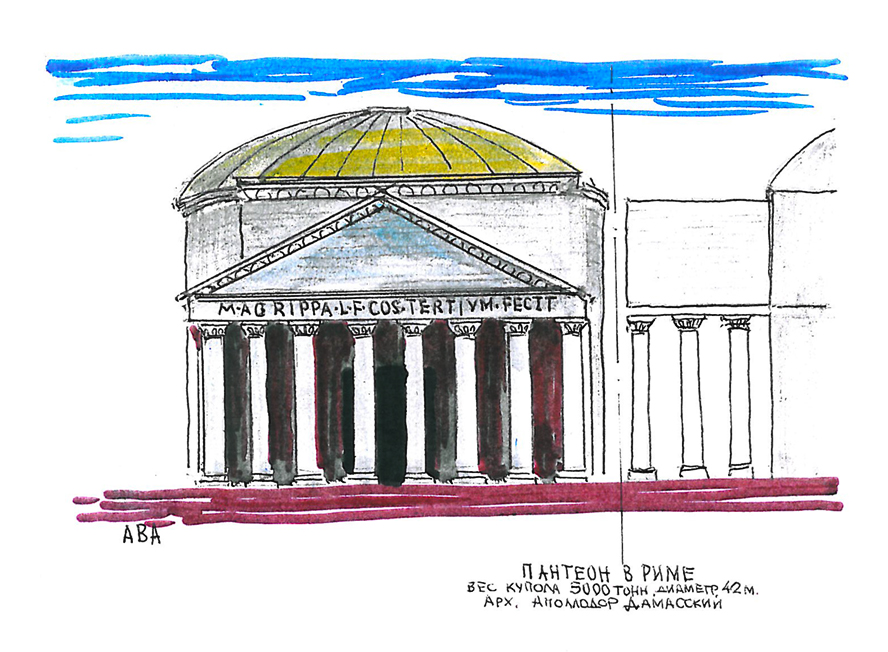Tralles and Ephesus
An old map on the faded papyrus leads us to the Mediterranean city of Tralles. We travel through its narrow streets with houses on both sides. We enter a courtyard of Stephanus’ house through a narrow arch in the wall - like through a needle's eye. The arch is so narrow that it's hard to imagine how a camel could squeeze through it. We are in a square-shaped courtyard. In its centre there is a fountain - a stone bowl made of dark green granite. The dark grey rim is smoothly polished. The fountain bursts with fresh and cool water, despite the hot autumn day. All the windows in the house are facing the courtyard. Above them there are awnings to protect from heat and accidental rain. The bright eastern sun shines. The courtyard is paved with stone tiles, on top of which there are carpets with nap of red and dark blue color.
The real treasure of the house were manuscripts. In those days books were hand written and had high value. They could be found only in the houses of rich people or in libraries. Stephanus and his sons were lucky that not far from Tralles there were cities with big libraries - Ephesus and Pergamon. The Library of Celsus in Ephesus had over 3000 scrolls on geography, mathematics, architecture, medicine, botany and other sciences.
In Ephesus the Temple of Artemis was situated – one of the Seven Wonders of the World. This temple had a long and dramatic history. Rich citizen of Ephesus were skilful bankers lending money at a high interest and they wanted to increase the turnover of the Bank of Artemis. They invited the architect Chersiphron from Knossos and offered him to build a marble temple surrounded by two rows of columns. The construction was started by Chersiphron in around 550 BC and continued by his son Metagenes. The temple had an impressive size of 110 x 55 m. The height of the temple was 18 m, which is approximately the height of a modern six-storey building.
According to Pliny, the temple was surrounded by 127 marble columns. Marble was found in the vicinity of Ephesus by a shepherd Pixodore, for which he was nicknamed Evángelos – the messenger that brought good news.
The columns were made at the site of the marble quarry and transported to the temple by rolling. Iron rods were inserted in the column ends on which large diameter wheels were mounted.
In 356 BC the temple was destroyed by fire set by Herostratus, a local resident who was seeking fame at any cost. That same night when the temple was burning Alexander the Great – the conqueror of Asia was born. After becoming emperor he offered the Ephesians a lot of money to restore the temple. The only condition of Alexander was a dedicatory inscription about his merits on the gable of the temple. However, cunning Ephesians tactfully replied that “it is not appropriate for a god on earth to build temples to other gods”.
Today only picturesque ruins of the glittering former buildings remain. The ruins are inhabited by small turtles crawling where ancient life once boiled, bazaars were buzzing and the genius architect Anthemius of Tralles was walking.
Read morePantheon in Rome
In Rome Anthemius of Tralles has visited the Pantheon completed by the emperor Hadrian at about 126 AD. The building is cylindrical with a portico of large granite Corinthian columns. The height of the building was 42.7 m., the diameter of the dome - 43.2 m. The massive walls of the building are 6.2 m. thick and were built on a brick and concrete foundation in which cement from volcanic ash was used. The walls contain voids inside to lighten the weight of the structure. Eight pylons are connected by arches supporting the dome.

© Valery Anfimov 2017
The dome was the top engineering invention of its time. It was composed of five horizontal layers of concrete and caissons, which create a sense of lightness, despite its huge weight - more than 5000 tons. At the very zenith of the dome there is a window (oculus) 9 meters in diameter, which created a special scattering light that smoothes out contrasts. The ocular light was shining on seven gods, which corresponded to seven planets - Sun, Moon, Venus, Saturn, Jupiter, Mercury and Mars. Inside the temple walls were decorated with marble slabs, and in the niches there were numerous statues of various gods of the Empire.
The floor of the temple was also lined with marble slabs with a circle of marble in the centere, which could be found in other temples, as well as in Hagia Sophia. It should be noted that the dome remained unsurpassed in size until the end of the 19th century, and the building served as a model for other buildings.
Anthemius spent some time standing in the square in front of the Pantheon and observing the temple of all Gods of the Empire. He focused attention on the giant dome, the support of which required the walls of extraordinary thickness, otherwise the dome would have crushed the entire structure.
In his imagination a new dome emerged, flatter, lighter, with the openings, that will provide the effect of detaching the dome from the temple and creating the illusion of it flying. As an engineer, he knew that this will require overcoming numerous obstacles, such as reducing the dome's weight, ensuring it can sustain earthquakes, and developing a new construction technology that had not been used before. The idea of a new dome possessed his imagination for many years and was successfully realized in the Hagia Sophia in Constantinople.
He also observed to the columns of the portico of the Pantheon, that were carved from monolith (height - 11.8 m, diameter - 1.5 m, weight - 60 tons), as in the Hagia Sophia he will use similar.
Read more
